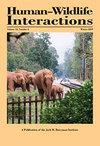Black Vulture Conflict and Management in the United States: Damage Trends, Management Overview, and Research Needs
IF 0.9
4区 环境科学与生态学
Q4 BIODIVERSITY CONSERVATION
引用次数: 14
Abstract
Contrary to rapid declines of many vulture (Accipitridae, Cathartidea) species worldwide, black vulture (Coragyps atratus) populations are increasing and expanding their range in North America. Vultures exhibit complex behaviors and can adapt to any humandominated landscape or land use. These traits, combined with population growth and range expansion, have contributed to increased human–vulture conflicts. Our goal was to summarize the current status and trends in human–black vulture conflicts (hereafter human– vulture conflicts), review available management strategies, identify knowledge gaps, and provide recommendations to enhance management and understanding of this species and the associated conflicts. We found human–vulture conflicts are increasing in agriculture (livestock), private and public property (both personal and infrastructure-based), and threats to human health and safety. The greatest increases in conflicts were reported in agriculture and private and public property damage. Regarding livestock depredation, good progress has been made toward assessing producer perceptions of the conflicts, including estimates of economic damage and mitigation strategies, but a basic understanding of the underlying mechanism driving the conflict and advancing strategies to mitigate damage is lacking. For damaged property, little information is available regarding economic losses and perceptions of stakeholders who are experiencing the damage, and most of the tools recommended for mitigating this damage have not been rigorously evaluated. Regarding human health and safety, recent research quantifying flight behavior of black vultures has direct implications for reducing aircraft collision risks. However, it is unclear what factors influence roost site selection and the most effective means to leverage the sensory ecology of the species to mitigate risks. We identify additional knowledge gaps and research needs that if addressed could increase managers’ understanding of black vulture ecology and facilitate enhanced management of this species while simultaneously allowing for the species to provide valuable ecosystem services.美国的黑秃鹫冲突与管理:损害趋势、管理概述和研究需求
与世界范围内许多秃鹫(秃鹰科,秃鹰科)物种的迅速减少相反,北美的黑秃鹫(Coragyps atratus)种群正在增加并扩大其活动范围。秃鹫表现出复杂的行为,可以适应任何人类主导的景观或土地使用。这些特征,再加上人口增长和活动范围的扩大,导致了人类与秃鹫之间冲突的增加。我们的目的是总结人类与黑秃鹫冲突的现状和趋势,回顾现有的管理策略,找出知识空白,并提出建议,以加强对该物种及其相关冲突的管理和了解。我们发现,在农业(牲畜)、私有和公共财产(包括个人财产和基础设施)以及对人类健康和安全的威胁方面,人类与秃鹫的冲突正在增加。据报告,冲突增加最多的是农业和公私财产损失。关于牲畜掠夺,在评估生产者对冲突的看法方面取得了良好进展,包括对经济损失和缓解战略的估计,但对推动冲突的潜在机制和推进减轻损害的战略缺乏基本了解。对于受损财产,几乎没有关于经济损失和遭受损失的利益攸关方看法的信息,而且大多数建议用于减轻这种损失的工具都没有经过严格评估。在人类健康和安全方面,最近的研究量化了黑秃鹫的飞行行为,这对降低飞机碰撞风险具有直接意义。然而,目前尚不清楚是什么因素影响了栖息地的选择,以及利用物种的感官生态来减轻风险的最有效方法。我们确定了额外的知识空白和研究需求,如果解决这些空白和研究需求,可以增加管理者对黑秃鹫生态的理解,并促进对该物种的管理,同时允许该物种提供有价值的生态系统服务。
本文章由计算机程序翻译,如有差异,请以英文原文为准。
求助全文
约1分钟内获得全文
求助全文
来源期刊

Human–Wildlife Interactions
Environmental Science-Nature and Landscape Conservation
CiteScore
2.80
自引率
0.00%
发文量
0
审稿时长
11 weeks
期刊介绍:
Human–Wildlife Interactions (HWI) serves the professional needs of the wildlife biologist and manager in the arena of human–wildlife conflicts/interactions, wildlife damage management, and contemporary wildlife management. The intent of HWI is to publish original contributions on all aspects of contemporary wildlife management and human–wildlife interactions with an emphasis on scientific research and management case studies that identify and report innovative conservation strategies, technologies, tools, and partnerships that can enhance human–wildlife interactions by mitigating human–wildlife conflicts through direct and indirect management of wildlife and increased stakeholder engagement. Our intent is to promote a dialogue among wildlife professionals concerning contemporary management issues. As such, we hope to provide a repository for wildlife management science and case studies that document and share manager experiences and lessons learned.
 求助内容:
求助内容: 应助结果提醒方式:
应助结果提醒方式:


